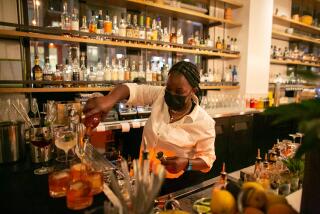Painting the town red: L.A. reopens restaurants, gyms, theaters as COVID numbers dip
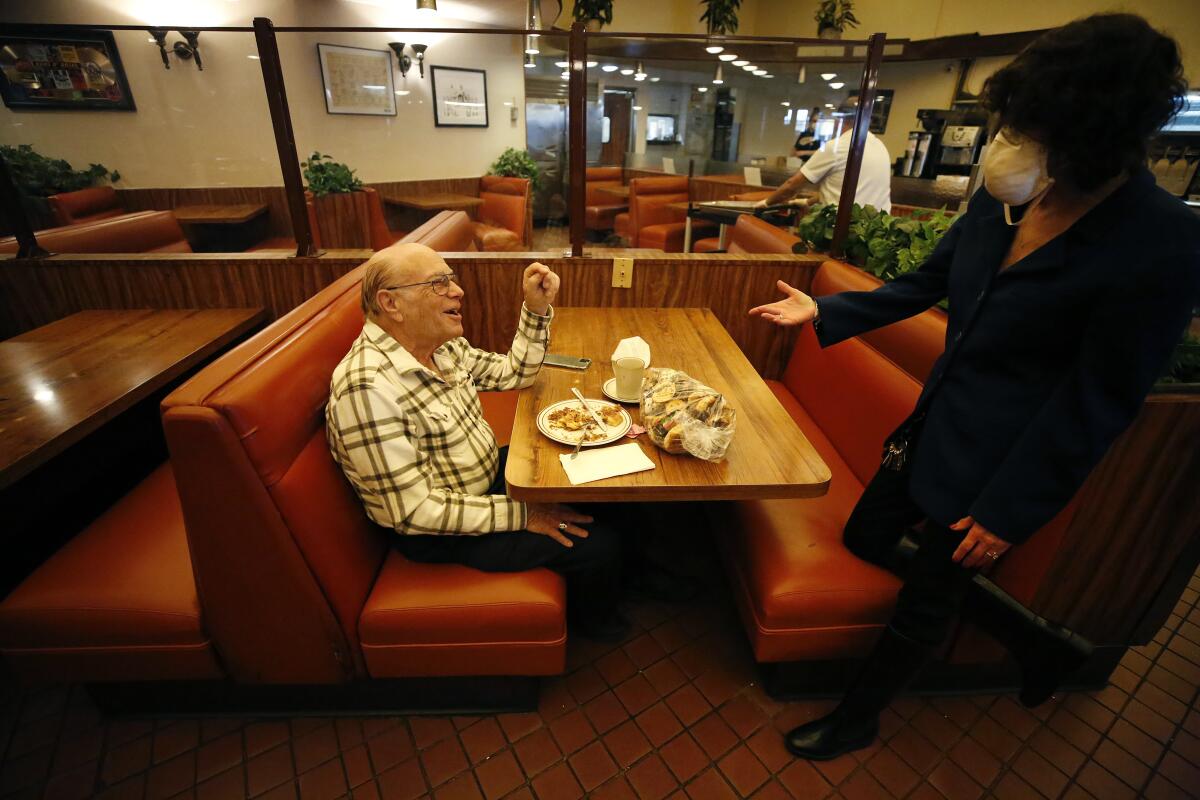
- Share via
Four regulars sat in booths at Canter’s Delicatessen on Monday, eating breakfast. Waitresses topped off coffee as a cashier picked up the phone, “Yes, we’re open.” This particular bit of normalcy came with a hint of pickle in the air.
After months of COVID-19 closures, Los Angeles County unlocked a significant portion of its battered business sector Monday, allowing in-restaurant dining, gym workouts, moviegoing and a host of other activities at indoor venues. Albeit with restrictions.
Proprietors and employees alike hope this round of reopenings will endure and give an adrenaline shot to an economy laid low by some of the strictest pandemic shutdowns in the nation.
Restaurants, movie theaters, gyms reopen in L.A. County today
“The sun is out and there’s a light at the end of the tunnel,” said Marc Canter, who co-owns Canter’s with his sister.
Two years ago, cafes opening up for their morning customers would have been as remarkable in Southern California as a gloomy day in June.
But in a world turned upside down by COVID-19, retrieving even a bit of the old normal is a ray of hope.
For Bob Knee, 72, who has been coming to Canter’s since he was 16, that restoration came in the form of sausage and eggs.
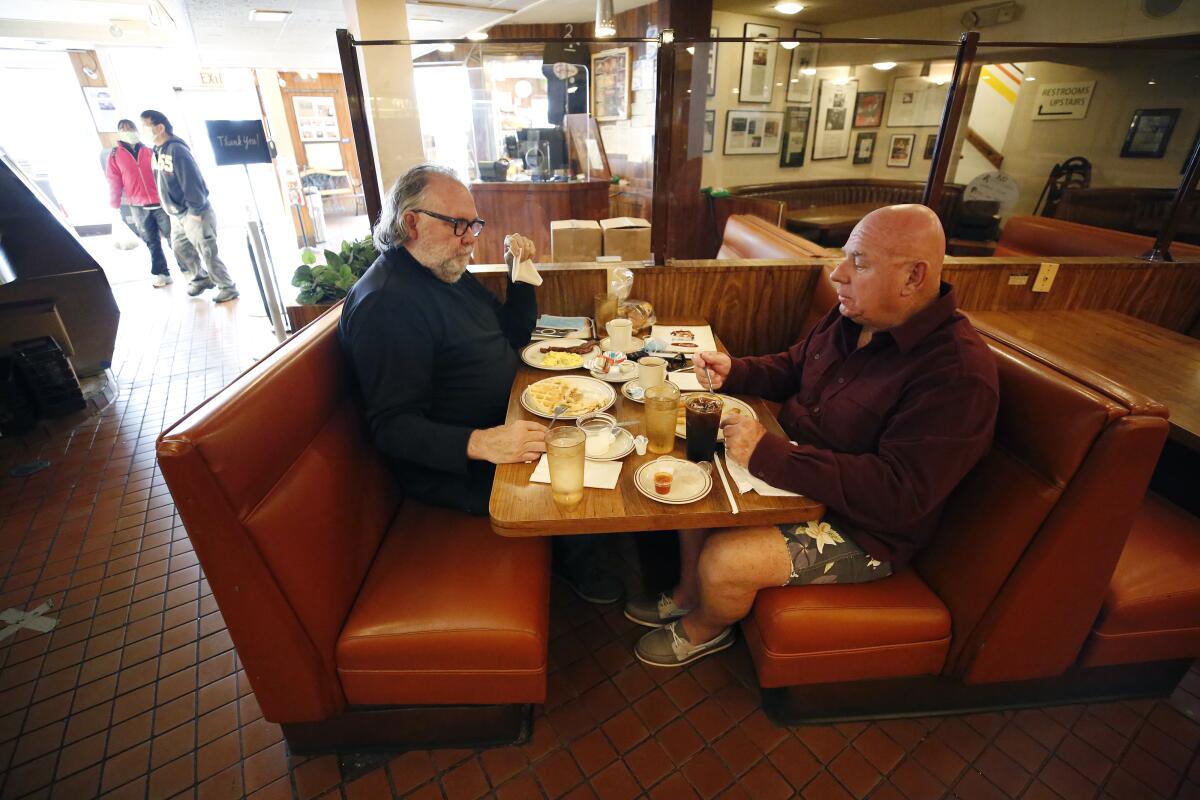
“It’s wonderful,” he said.
A year ago, co-owner Jacqueline Canter spent her birthday furloughing about 100 employees by phone.
“It was so heartbreaking,” she said. “I had no idea [the pandemic] would go on for a year.”
She spent this birthday weekend calling employees to offer their jobs back. The famous deli in the Fairfax district was reopening.
“Now that we’re open, it’s certainly a good birthday,” Canter said. “My birthday wish came true.”
L.A.’s wider reopening came as COVID-19 cases continue to drop from a January peak and as the number of people vaccinated rises. But business as usual remains a distant concept, and those establishments that are open are still subject to restrictions on how many customers can be served at a time, as well as requirements for physical distancing and face coverings.
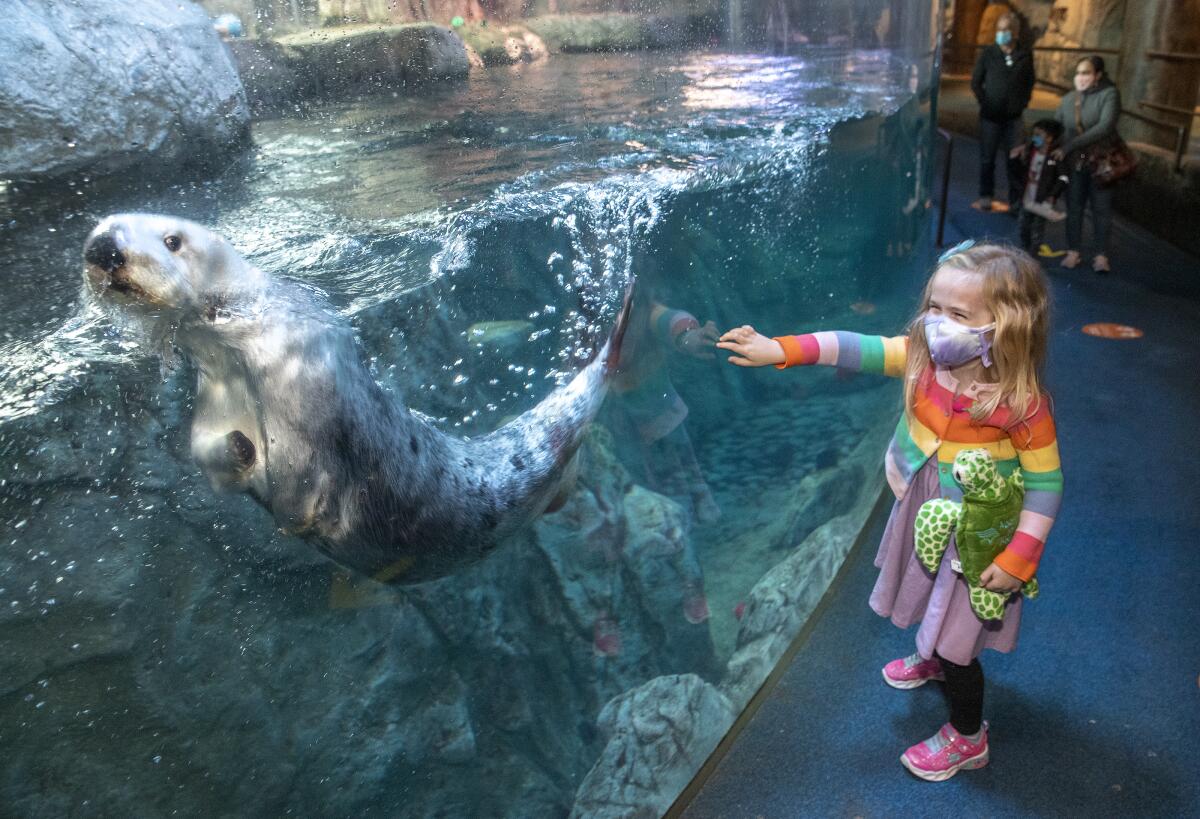
L.A. County Public Health Director Barbara Ferrer said Monday that “just because certain activities are allowed, or certain reopening protocols are revised, does not mean that these activities are 100% safe and without risk.”
“We’re still in the middle of a pandemic, and whenever there are more opportunities for interactions with people not in your household, there could be more transmission of the virus,” she said during a media briefing. “We do, however, have the tools to protect ourselves from increased transmission. We just need to use them and not get complacent.”
The move to ease restrictions was made possible by L.A. County’s advancement from the purple tier, the strictest category in the state’s four-level coronavirus road map, to the more lenient red tier.
A dozen other counties — Orange, San Bernardino, Contra Costa, Sonoma, Placer, Mendocino, San Benito, Tuolumne, Siskiyou, Amador, Colusa and Mono — also officially progressed over the weekend.
Those 12, along with L.A., are home to 17.7 million Californians.
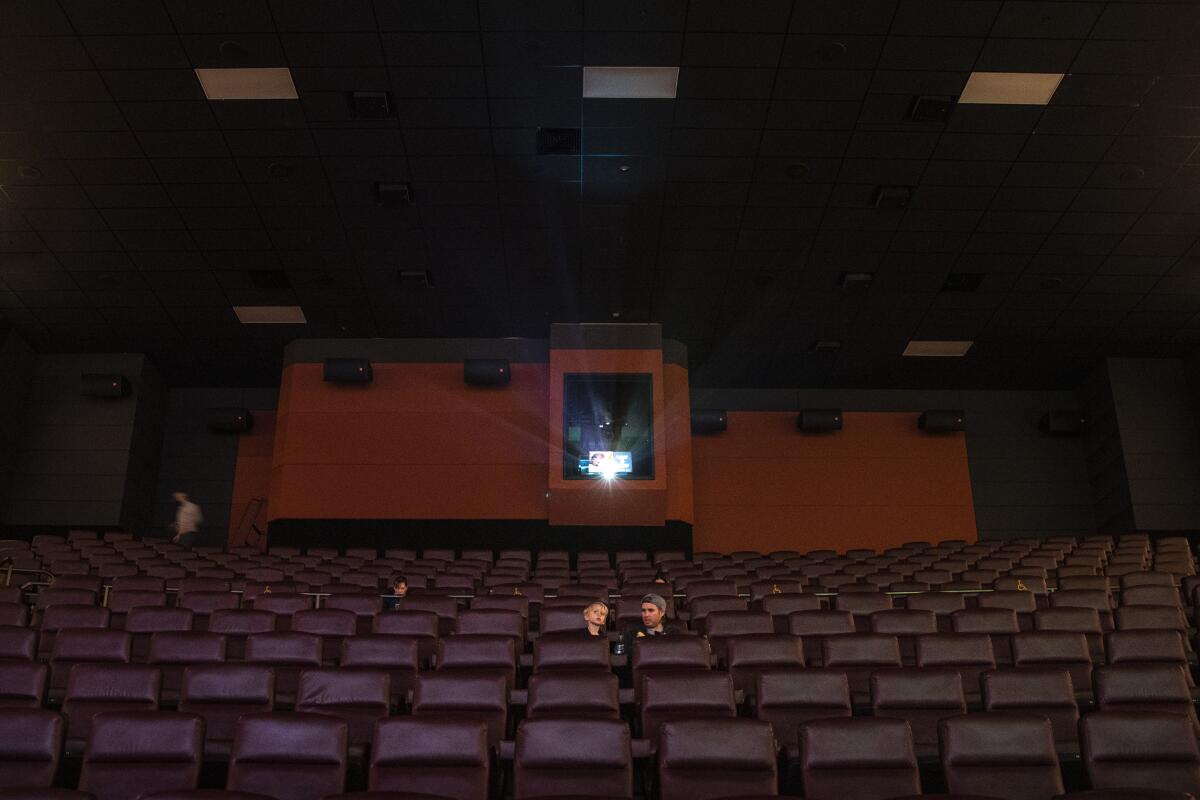
Moving from purple to red clears the way for those counties to allow indoor dining at restaurants and for movie theater showings at 25% capacity; welcome back students in person in grades seven through 12; reopen indoor gyms and dance and yoga studios at 10% capacity; and expand capacity restrictions at nonessential stores and libraries.
Museums, zoos and aquariums also can reopen indoor operations at 25% capacity.
Starting April 1, amusement parks can reopen at 15% capacity, with other modifications, in red-tier counties. Attractions such as Disneyland, Universal Studios, Knott’s Berry Farm and Six Flags Magic Mountain will initially be required to limit visitors to California residents.
Outdoor sports, with fans, and outdoor live performances also will be allowed to resume April 1, provided restrictions are adhered to on capacity and concession sales, which vary based on a home county’s tier assignment.
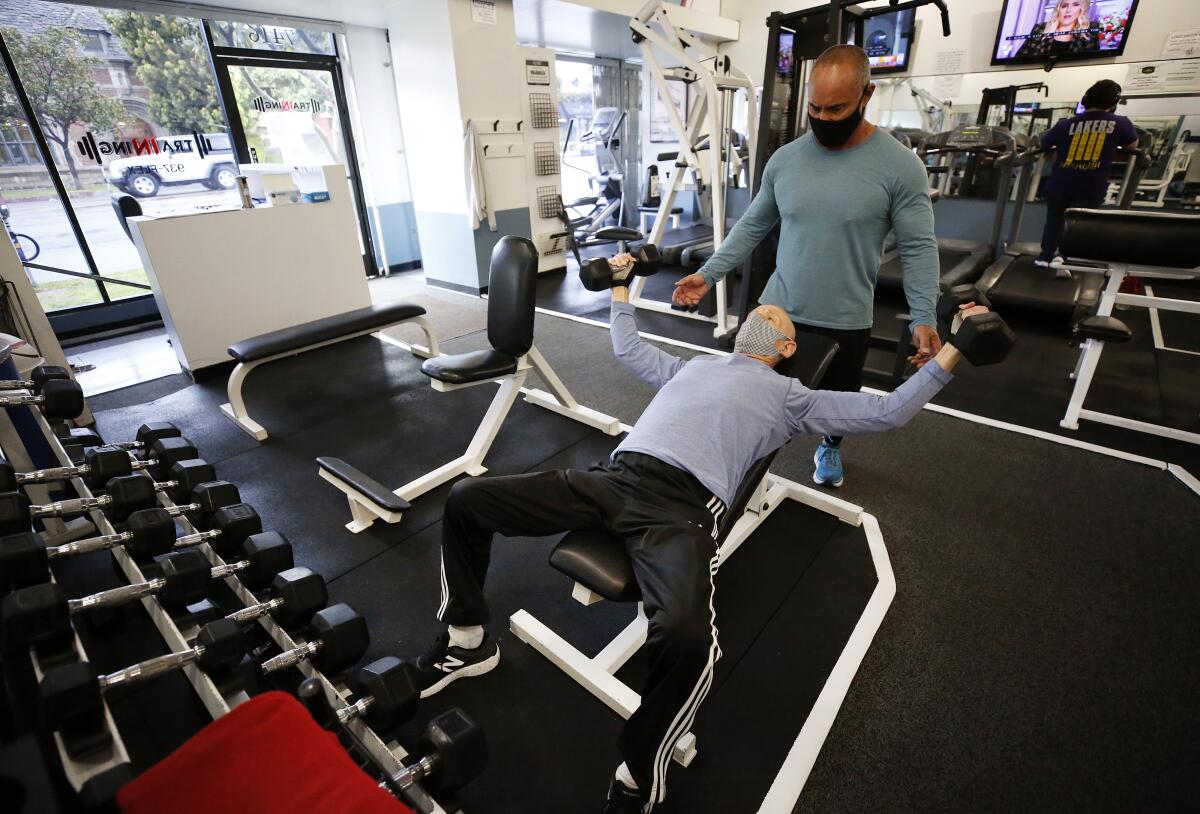
In Inglewood, Haqumai Sharpe hit the gym after not visiting his local L.A. Fitness for a year.
“It’s been a while,” said Sharpe, 47. “I just missed my routine.”
He arrived before noon so he could scope out an isolated area to lift weights.
During the lockdown, he shifted his workouts to playing tennis and running near his neighborhood.
“Now that I’ve been vaccinated, I feel like I can step outside of the norm and go back to the gym,” he said.
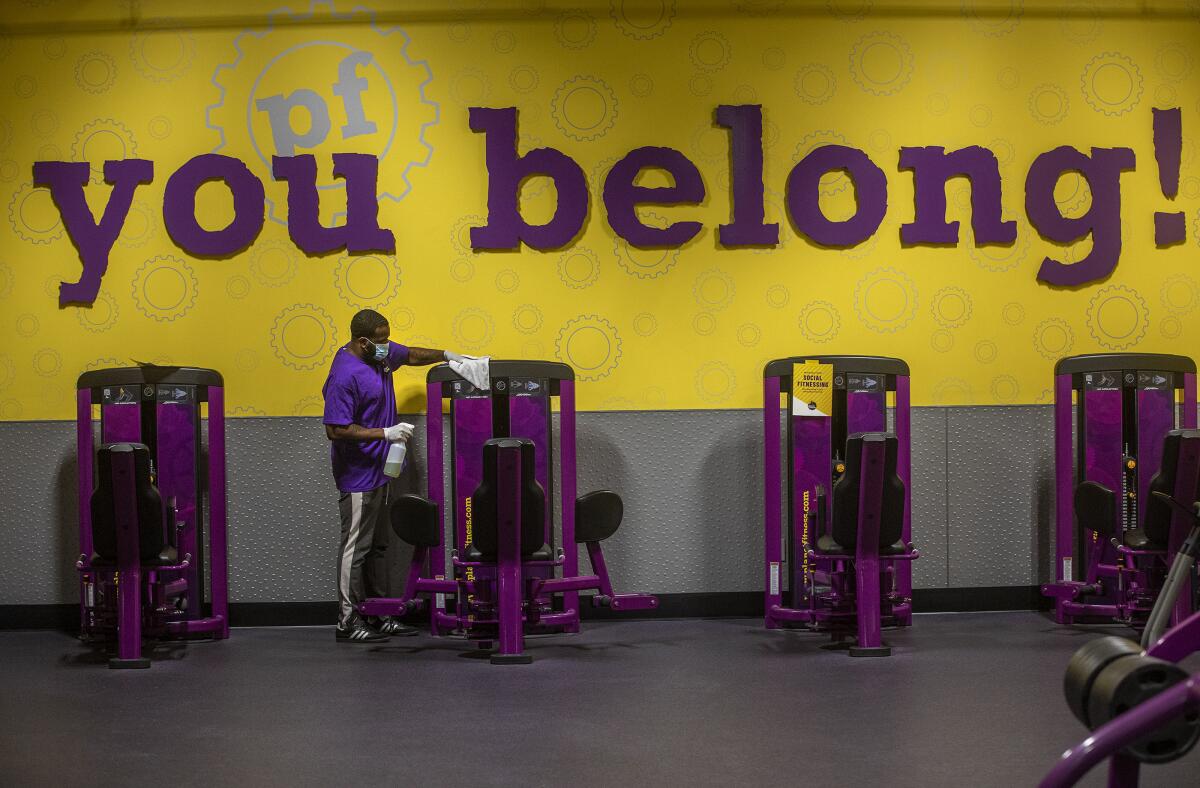
He joined a steady stream of gym members hoping to reclaim pieces of their old lives.
Frederic Osho said he lost all motivation during the lockdown.
“I put on weight. I was depressed. It was terrible,” he said. “I did home workouts, but it’s nothing like the gym.”
The reopening offered other people an escape from their physical reality.
In Downey, Carl Jonson rushed into the Cinemark theater, excited to see the movie “Boogie.”
“I’m feeling great,” he said, giving two thumbs up. “Feeling amazing.”
An avid moviegoer, the Lynwood resident has been eagerly waiting for theaters to open.
“I’m happy to be back at the theater,” he said. “And I got vaccinated today, so feeling even better.”
But signs of the ongoing pandemic made clear this was only a fractional return to the routine. Except for murmuring and the hum of the popcorn machines, the cinema was quiet. Food was limited. The soda machines and water fountains were cordoned off. The arcade was closed. Seats in the theaters were roped off to keep viewers spread apart.
Cristal Viramontez, a 33-year-old Norwalk resident, said she has getting sick of staying at home and has been looking for ways to get out. She and her family wanted to see “Boogie” and thought they might be able to stream it online, but were surprised to find Monday that it was showing in neighboring Downey.
She and her family sat in the dark theater apart from one another — Viramontez with her son in the lower seats and her husband and daughter in the upper seats.
“I missed it a lot, it’s actually really nice,” she said.
In Lakewood, Cecilia Maya, 33, and Jennifer Rivera, 21, had grown so accustomed to life in the time of COVID that they were surprised they were allowed to sit inside Collaborative Coffee Bar as rain drizzled outside.
“It didn’t hit me that we’d be able to sit indoors,” Maya said. “You just adapt to living this way.”
For a couple of friends and new entrepreneurs who consider coffee hopping a way of life, the cafe opening was a big deal. “Let’s start our week off great,” Maya told Rivera.
It was their second time sitting inside a coffee shop in about a year. The first time was in January on a trip to Tijuana. That experience “felt like we were gonna get busted,” Maya said. “We were so used to not being able to be out.”
Maya and Rivera, along with Rivera’s father, run a steel manufacturing business in City of Commerce that they started in summer 2019. Before the pandemic, coffee shops were their only working space. They’d hunt down the perfect space with Wi-Fi and outlets and work for eight hours in one spot. When COVID hit, Collaborative Coffee created an outdoor space like many other coffee shops; but for Rivera and Maya, it just wasn’t the same.
“I feel like [outdoors] people are just eyeing you, asking: Are you leaving?” Rivera said. “Indoors, you’re just chilling. Here, I can set up camp.”
It’s the intimacy, the murmurs of people talking, the background music and whir of the coffee machine that makes it a special experience. “We’ve all vented, we’ve all laughed, we’ve all dreamed at coffee shops,” Maya said.
“It really felt like something was taken from me. It’s such a big part of my identity. Some people felt bummed because they couldn’t go to the gym or the club. I felt heartbroken I couldn’t sit at Tierra Mia or La Monarca in Boyle Heights.”
When Robert Lopez, 30, opened the cafe in the summer of 2019, he wanted to create a comfortable space for entrepreneurs and creators who are Black, Indigenous or people of color, and for fellow community members in the Lakewood and Long Beach area. He named his cafe in that spirit and enjoyed a strong first eight months.
On Friday afternoon he saw the news that some county businesses would be able to open indoor seating with limited capacity.
On Sunday he rearranged the seats so people would be safely distanced.
As customers came in, his excitement was dampened by the ongoing uncertainty.
“What if that thing we’re hoping for is taken away right away?” Lopez said. “You want to be excited and hopeful, but you just don’t know. It leaves you in a place where your security is not all there.”
Times staff writers Luke Money, Matthew Ormseth, Sonja Sharp and Alex Wigglesworth contributed to this report.
More to Read
Sign up for Essential California
The most important California stories and recommendations in your inbox every morning.
You may occasionally receive promotional content from the Los Angeles Times.

